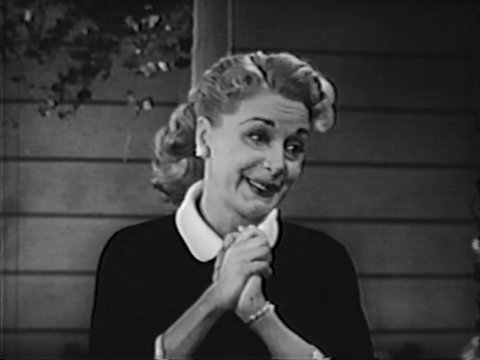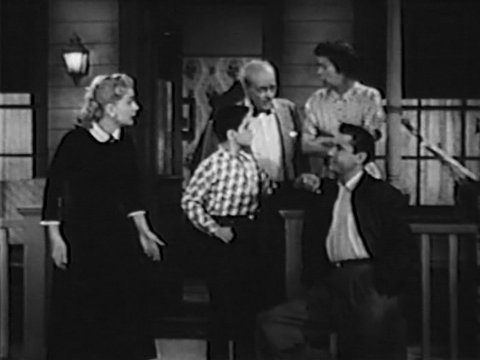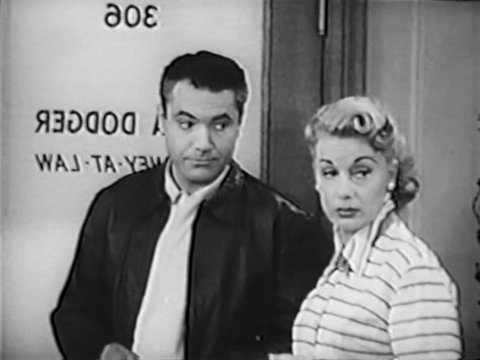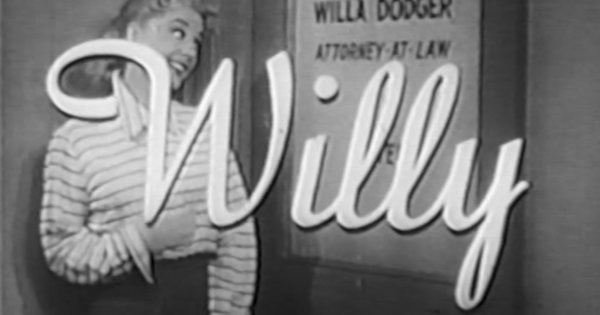June Havoc starred in this 1954-1955 CBS sitcom as a small town lawyer, making it the first prime time TV show with a female lawyer main character. Moving the action to New York City at mid-season failed to increase ratings. Although the show aired in off-network syndication for several years, it soon faded into obscurity.
A Television First
Willy, starring June Havoc, is believed to be the first prime time television program about a female lawyer. According to the Tarlton Law Library, NBC’s daytime serial Miss Susan, starring Susan Peters, was the very first television program to feature a female lawyer when it debuted in March of 1951 [1]. Another daytime serial, Portia Faces West, starring Frances Reid, began on CBS in April of 1954. Then, in September of 1954, CBS premiered Willy in prime time. The same network was responsible for the first prime time dramatic television program with a female lawyer, Kate McShane, starring Anne Meara, but not until 1975.
In Willy, June Havoc played Willa “Willy” Dodger, attorney-at-law, who spent four years at night school studying law (her paternal grandfather, William Makepeace Dodger, had been a circuit judge and helped inspire her to become an attorney). After taking the bar and setting up an office, it was six months before she got her first case, which was depicted in the premiere episode.
A Troubled History
Willy was created by William Spier and Louis Pelletier; the two co-wrote the pilot script. Spier, who was married to June Havoc from 1948 until his death in 1973, also directed the pilot, which was filmed in front of a live audience on Thursday, April 29th, 1954 at Motion Picture Center (later known as Desilu Studios, Desilu-Cahuenga Studios and currently Ren-Mar Studios) in Hollywood [2]. At the time, the pilot was titled “My Aunt Willy,” although previously it had been called “The Artful Miss Dodger” [3]. According to Coyne S. Sanders and Tom Gilbert, the original working title was “Miss Bachelor at Law” [4].
“My Aunt Willy” was one of four pilots Desilu Productions filmed for the 1954-1955 season. The others were “December Bride” with Spring Byington, “Country Doctor,” with Charles Coburn” and “Mr. Tutt” with Walter Brennan. Spier was involved in both “Country Doctor” and “Mr. Tutt,” in addition to “My Aunt Willy.” In late May of 1954, General Mills signed on as sponsor for “My Aunt Willy,” although The Billboard reported that the sitcom wouldn’t go by that name when it premiered in the fall; network and time slot had also yet to be determined [5]. By mid-July, although still untitled, ABC had expressed interest in picking up the show and giving it the Friday 7:30-8PM time slot, where it would replace The Stu Erwin Show [6].
NBC apparently expressed some interest in acquiring the show, or at least offering to air it in an attempt to get into the good graces of General Mills. In a complicated bit of maneuvering, The Billboard suggested that should the network succeed in convincing Pet Milk to share sponsor duties for The George Gobel Show in the Saturday 10-10:30PM half-hour with Armour, dropping its sponsorship of The Original Amateur Hour in the process, NBC might approach General Mills about the Saturday 8:30-9PM time slot formerly held by The Original Amateur Hour [7]. Offering such a “good evening slot” to General Mills might lead the sponsor to then purchase some daytime half-hours on NBC.
Pet Milk did drop its sponsorship of The Original Amateur Hour and agree to co-sponsor The George Gobel Show for the 1954-1955 season, but NBC filled the Saturday 8:30-9PM half-hour with Place the Face, which moved from Wednesdays. Meanwhile, even without a firm network and time slot — General Mills was said to have optioned a time slot on ABC — Desilu announced it would begin production on the show August 2nd at Motion Picture Center, with “The Artful Miss Dodger” as a temporary title. George M. Cahan would direct, with William Spier producing and overseeing the scripts; Louis Pelletier, Alan Lipscott and Bob Fisher would serve as writing team [8].
In July, when ABC began announcing its plans for the fall, which included launching Disneyland and broadcasting a lot of football, one of its new filmed programs was said to be June Havoc’s as-yet-untitled sitcom [9]. In early August, CBS made a play for another filmed series ABC was “reportedly certain to acquire,” The Halls of Ivy, convincing International Harvester to bring in a co-sponsor, Nabisco, and giving the show the Tuesday 8:30-9PM half-hour [10]. At the same time, General Mills was expressing interest in placing its June Havoc sitcom in the Tuesday 8-8:30PM half-hour on CBS.
Then, in mid-August, General Mills announced that it would not continue sponsoring ABC’s Friday 7:30-8PM half-hour for the 1954-1955 season as had been expected, meaning the June Havoc sitcom would not take over that time slot. Instead, The Billboard reported that it would likely air on CBS Saturdays from 10:30-11PM [11]. That made two filmed sitcoms CBS had snatched away from ABC. In return, ABC was able to convince Nabisco to bring it The Adventures of Rin Tin Tin, for use in the same Friday 7:30-8PM time slot that General Mills had abandoned. CBS had hoped to air the show on Sunday afternoons [12].
Throughout this confusion, Desilu continued production and ultimately settled on a name for the show.
June Havoc As Willy Dodger, Attorney-At-Law
Willy premiered on Saturday, September 18th, 1954. It competed with Your Hit Parade on NBC and local programming on ABC. When the series began, Willy was living with her father, sister and nephew in the small New England town of Renfrew, New Hampshire. The premiere episode told the story of Willy’s first legal case, which involved a dog that had supposedly scared a cow to such a degree that it wouldn’t give milk. The cow’s owner wanted the dog put down. The dog was owned by a friend of Willy’s nephew so she agreed to take the case. Ultimately, money from case allowed Willy to keep a set of law books from being repossessed.
Joining June Havoc in the cast were Mary Treen as Emily, Willy’s widowed sister, and Danny Richards, Jr. as Franklin, her nephew. There is some confusion about who portrayed Willy’s father in the series, with both Wheaton Chambers and Lloyd Corrigan identified as playing “Papa” Dodger (his real name was Walter). Chambers was credited in the premiere, his name misspelled as Weaton Chambers, but he may have been replaced after the first episode or at a later date. On the other hand, Chambers could have played the role throughout the series. Rounding out the cast was Whitfield Connor as Charley, Renfrew’s veterinarian and Willy’s boyfriend.

June Havoc as Willy
C. E. Butterfield, radio/television editor for the Associated Press, writing about the premiere, suggested that “the story sounds as if it might develop, although it may take a little time to build up an audience” [13]. Larry Wolters of The Chicago Daily Tribune called Havoc’s character “a young Portia,” referring to the legally adept heroine of Shakespeare’s The Merchant of Venice [14].
Early episodes saw Willy dealing with stocks, an unwanted nomination for town assessor, a Los Angeles job offer, an unhappy divorce and defending a man who thinks he can find water hidden underground.
Ratings And Disbelief
On January 1st, 1955 The Billboard reported that NBC was trying to woo General Mills into bring its business to the network [15]. In a complicated bit of maneuvering, NBC would need to convince Pontiac to give up a half-hour on Friday evenings, currently filled with The Red Buttons Show, into which General Mills could move Willy. Should Willy not be renewed, a new show would be found for the 1955-1956 season.
On January 8th, The Billboard revealed that Willy was one of several programs — others were The Halls of Ivy and Hey, Mulligan — unlikely to return for another season [16]. Finally, on January 29th, The Billboard noted that General Mills wanted to replace Willy for the 1955-1956 season and had invited five advertising agencies to pitch new ideas [17]. Based on Nielsen’s second December report, Willy was averaging a 10.8 rating, the lowest of new CBS programs and one of the lowest out of all new programs for the 1954-1955 season [18]. Its Trendex rating for the week of January 9th was a 10.4, the third lowest of new CBS programs and again among the lowest out of all new shows [19].

Willy’s Friends and Family
June Havoc, in a February 1955 Associated Press article, revealed that she was finding it difficult to convince viewers that female lawyers existed and, in turn, that they “don’t all look like Victorian spinsters” [20]. According to Havoc, the legal elements of the series came from a pair of attorneys at Motion Picture Center where the series was filmed. Said Havoc, “we try not to lean too much toward the legal angle. For one thing, it wouldn’t do to have too many courtroom scenes. Comedy in a court would seem disrespectful and ours is a comedy show” [21].
Changes And Cancellation
Wayne Oliver, in the same Associated Press article, reported that changes were in store for Willy. The action would shift from the small town of Renfrew to the hustle and bustle of New York City. To facilitate the move, Willy would be getting a job with the American Guild of Variety Artists (or AGVA). Gypsy Rose Lee, June Havoc’s sister, had previously served as vice president of AGVA, likely Havoc some background to work with, and Havoc visited the real AGVA to prepare. According to Oliver, the change was made to “take more advantage of Miss Havoc’s comedy and dancing talents” [22].
The change took place in March of 1955. Willy’s family, although initially reluctant, makes the move to New York City with her. Charley, however, does not. Willy doesn’t get off on the right foot in the big city. Her new boss, Perry Bannister (played by Hal Peary), thought he was hiring a male lawyer. The organization Willy worked for in New York City may have been called the Bannister Vaudeville Company rather than the aforementioned American Guild of Variety Artists. Also joining the cast was Sterling Holloway as Harvey Evelyn, an old friend of Willy’s who ran a repertory theater. Episodes set in New York involved Willy being accused of theft, her sister becoming a dressmaker, a clothing drive gone awry, a weather-making machine and a Flamenco dancer’s marriage problems.
Following its March 26th, 1955 broadcast, CBS shifted Willy to Thursdays at 10:30PM. On May 7th, The Billboard reported that although still in production (filming would be completed in mid-May) Willy had been dropped by General Mills [23]. On May 20th, Hedda Hopper revealed that after completing work on Willy, June Havoc checked into a hospital for five days of rest and relaxation; Hopper referred to her as “a whirling dervish on and off screen” [24]. Willy ended its first and only season on June 16th, 1955 after 39 episodes. Repeats would continue throughout the summer.

Whitfield Connor and June Havoc as Charley and Willy
In July, The Billboard reported that Official Films had “taken over distribution” of the series and planned to “put it into syndication immediately for a fall start” [25]. Repeats aired through the remainder of the 1950s. In 1957, June Havoc gave her explanation for why the series failed:
“I don’t think there’s a situation comedy in the history of TV that could go on at 10:30 Saturday evening and get a rating. By 10:30, anyone who’s been watching TV is cockeyed. ‘Willie’ [sic] was made for a family to watch in a group, and you just find me one family that sits around a TV set in a lump at 10:30 on Saturday night!” [26]
Aaron Spelling had a small role in the very first episode of the series, playing a dog catcher. Joseph Kearns, Phyllis Coates and Joe Besser also made guest appearances on the show.
Works Cited:
2 “Desilou Packages: ‘My Aunt Willy,’ 3d in Skein of 4, to Roll.” Billboard. 1 May 1954: 5.
3 Ibid.
4 Sanders, Coyne Steven and Tom Gilbert. Desilu: The Story of Lucille Ball and Desi Arnaz. 1993. New York: HarperCollins, 2001: 93.
5 “General Mills Buys Desilu’s Havoc Series.” Billboard. 5 Jun. 1954: 7.
6 “Big Scramble On for ABC-TV Time, as Majors Near Sell-Out.” Billboard. 19 Jun. 1954: 4.
7 “NBC-TV Would Shift Time and Talent on Pet.” Billboard. 3 Jul. 1954: 2.
8 “Desilu to Roll August 1 on Havoc Series.” Billboard. 10 Jul. 1954: 13.
9 Butterfield, C.E. “ABC Maps Campaign Against Video Rivals.” Associated Press. Miami Daily News. 20 Jul. 1954: 8-A.
10 “CBS-TV Beats Out ABC-TV in ‘Ivy’ Quest; to Air Tuesday.” Billboard. 14 Aug. 1954: 9.
11 “Gen. Mills to Quit ABC-TV Friday Nights.” Billboard. 21 Aug. 1954: 15.
12 “Rin Tin Tin For Tat: ABC’s Dog Show To Even CBS Score.” Billboard. 28 Aug. 1954: 2.
13 Butterfield, C.E. “TV’s Fall-Winter Shows: New Entertainment Is Of High Order.” Associated Press. Miami Daily News. 23 Sep. 1954: 5-B.
14 Wolters, Larry. “Some May Go Out with the Ebb Tide.” Chicago Daily Tribune. 19 Sep. 1954: W12.
15 “NBC Stalks General Mills’ $3,500,000.” Billboard. 1 Jan. 1955: 2.
16 “Expanded Vidpix Programming Replacements Augur Big ’55.” Billboard. 8 Jan. 1955: 4.
17 “GM Agencies To Air Plans.” Billboard. 29 Jan. 1955: 2.
18 “Nielsen and Trendex: Season’s New Shows’ Ratings On Networks.” Billboard. 5 Feb. 1955: 2.
19 Ibid.
20 Oliver, Wayne. “TV ‘Lawyer’ June Havoc Fights Back.” Victoria Advocate [Victoria, Texas]. Associated Press. 17 Feb. 1955: 26.
21 Ibid.
22 Ibid.
23 “Summer Hiatus In Film: Output Hits a Year’s Low But Boom Augured for Fall.” Billboard. 7 May 1955: 18.
24. Hopper, Hedda. “Colbert Avoids TV Breakdown.” Miami Daily News. 20 May 1955: 68.
25 “Official Films Sets ‘Willy’ Syndication.” Billboard. 16 Jul. 1955: 7.
26 “Havoc Has Reason For ‘Willie’s’ Flop.” Hartford Courant. 11 Aug. 1957: 8.
Originally Published July 14th, 2010
Last Updated May 7th, 2018





I might be able to dig up a review of the series…I’ll take a look.
where might I find episodes and do you know who controls the rights to the show/owns the master footage now?
The show in question is owned by CBS Studios/CBS Television Distribution (as successors in interest to Desilu/Paramount Television/Viacom/CBS Paramount Television.)
Thanks for the great write-up of a show I had never heard of. The clips make me think viewers didn’t know what they were missing. Thanks, too, for this great site.
It’s hard to imagine how much power the major sponsors once had when one company was basically “footing the bill” and buying up most of the commercials for a television series’ entire season, or in some cases the complete series’ run.
Of course, the networks were still free to make foolish scheduling decisions….
I just found this review. Thanks for posting it. I recognize Mary Treen in the dancing clip, dressed up in an apron. Ms. Treen reminded me a lot of Mary Wickes and took to maid roles well, from her regular role on THE JOEY BISHOP SHOW to her guest role on THE BRADY BUNCH.
I also recognize Will Wright as the man in the final clip. He was very busy on television through his remaining years, making guest appearances on THE ANDY GRIFFITH SHOW and THE DICK VAN DYKE SHOW (the first actor to play Rob Petrie’s dad) not long before his passing in 1962.
Just watched “Gypsy” on PBS and my memory raced back to June’s tv show from the 1950’s. We first got our tv in 1954 and I remember faithfully watching “Willy.” Would love to see these episodes again.
It would be great to see reruns of this show again – or on CD – looks like a great show many of us have never experienced. I know I love Executive Secretary (Susie) and the Ann Sothern show, and Life with Elizabeth was great in its own way – and “its a wonderful life” –